COMP 1004 - Cash Management System Analysis and Design Report
VerifiedAdded on 2023/03/30
|23
|5608
|341
Report
AI Summary
This report presents a system analysis and design for a cash management system, focusing on addressing the challenges faced by Bank Muscat with its manual system. The report includes a feasibility study, problem identification, and proposed system features. It details input/output designs, context diagrams, and data flow diagrams. Alternative solutions are explored, with a recommendation for a global cash information management system. The analysis covers aspects such as upfront cost, business requirements, development language, system integration, software ownership, and upgradeability. The report concludes with recommendations for system implementation and future improvements. Desklib offers similar solved assignments and resources for students.
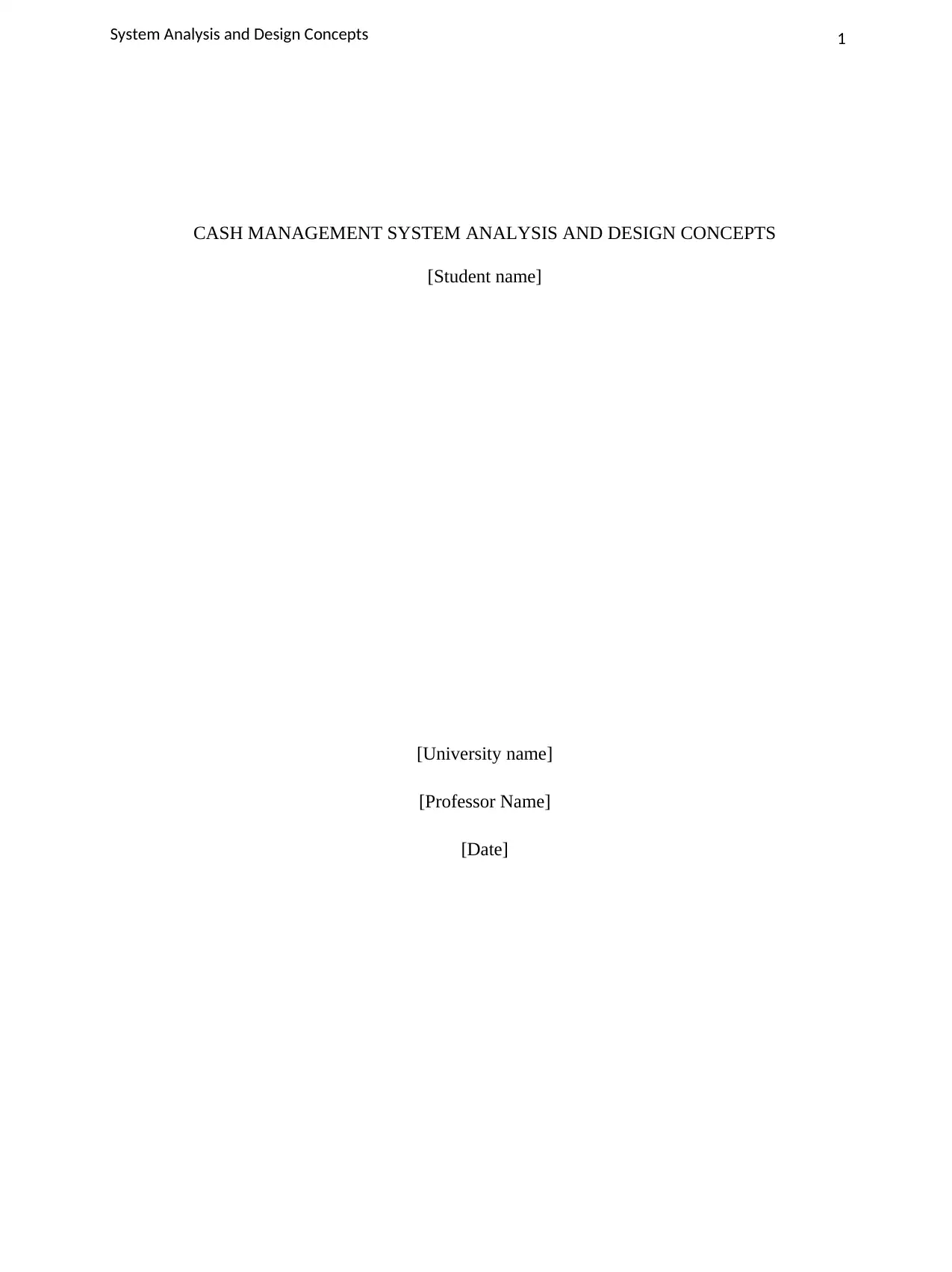
1System Analysis and Design Concepts
CASH MANAGEMENT SYSTEM ANALYSIS AND DESIGN CONCEPTS
[Student name]
[University name]
[Professor Name]
[Date]
CASH MANAGEMENT SYSTEM ANALYSIS AND DESIGN CONCEPTS
[Student name]
[University name]
[Professor Name]
[Date]
Paraphrase This Document
Need a fresh take? Get an instant paraphrase of this document with our AI Paraphraser
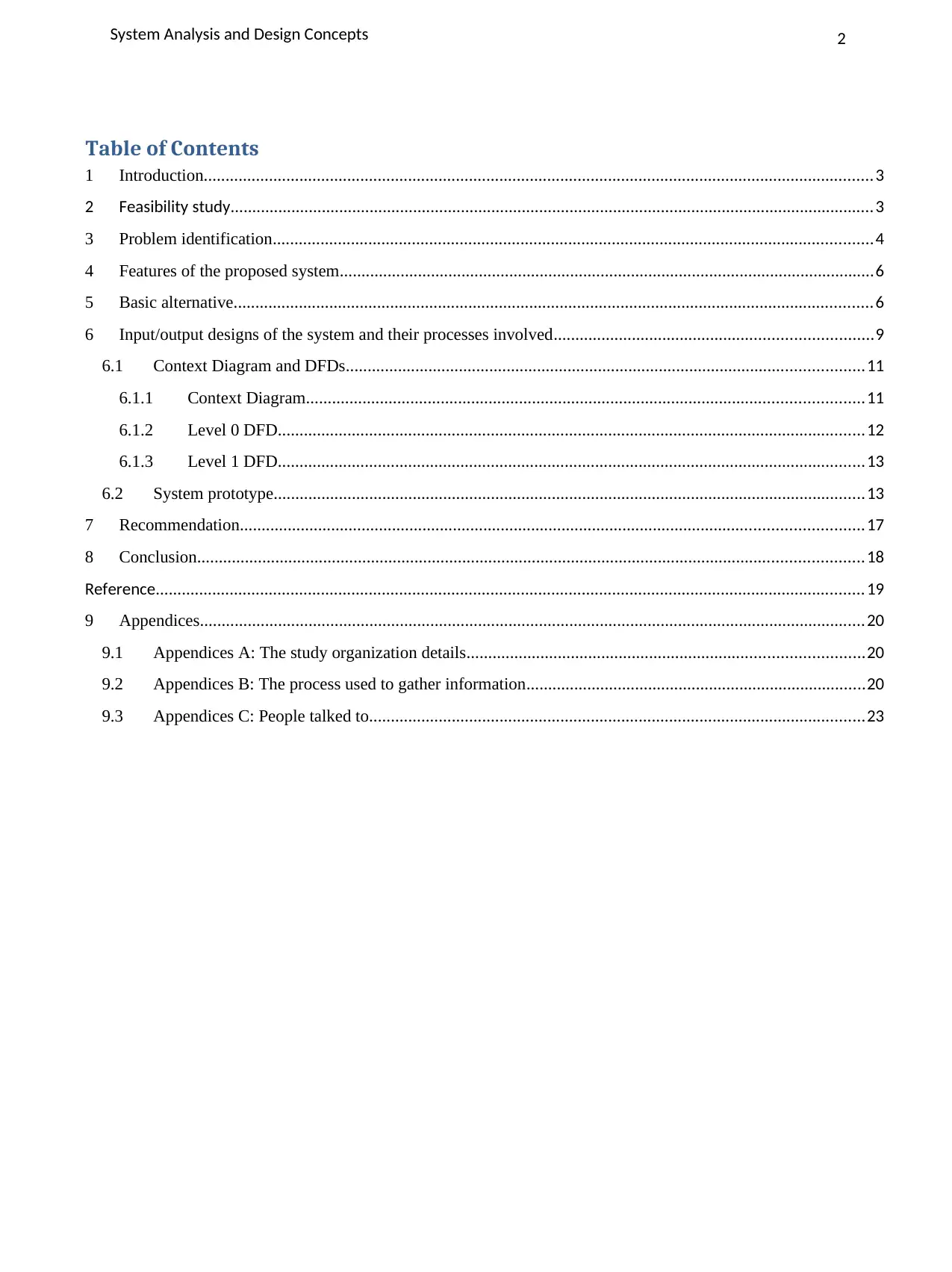
2System Analysis and Design Concepts
Table of Contents
1 Introduction..........................................................................................................................................................3
2 Feasibility study....................................................................................................................................................3
3 Problem identification..........................................................................................................................................4
4 Features of the proposed system...........................................................................................................................6
5 Basic alternative...................................................................................................................................................6
6 Input/output designs of the system and their processes involved.........................................................................9
6.1 Context Diagram and DFDs.......................................................................................................................11
6.1.1 Context Diagram................................................................................................................................11
6.1.2 Level 0 DFD.......................................................................................................................................12
6.1.3 Level 1 DFD.......................................................................................................................................13
6.2 System prototype........................................................................................................................................13
7 Recommendation...............................................................................................................................................17
8 Conclusion.........................................................................................................................................................18
Reference...................................................................................................................................................................19
9 Appendices.........................................................................................................................................................20
9.1 Appendices A: The study organization details...........................................................................................20
9.2 Appendices B: The process used to gather information..............................................................................20
9.3 Appendices C: People talked to..................................................................................................................23
Table of Contents
1 Introduction..........................................................................................................................................................3
2 Feasibility study....................................................................................................................................................3
3 Problem identification..........................................................................................................................................4
4 Features of the proposed system...........................................................................................................................6
5 Basic alternative...................................................................................................................................................6
6 Input/output designs of the system and their processes involved.........................................................................9
6.1 Context Diagram and DFDs.......................................................................................................................11
6.1.1 Context Diagram................................................................................................................................11
6.1.2 Level 0 DFD.......................................................................................................................................12
6.1.3 Level 1 DFD.......................................................................................................................................13
6.2 System prototype........................................................................................................................................13
7 Recommendation...............................................................................................................................................17
8 Conclusion.........................................................................................................................................................18
Reference...................................................................................................................................................................19
9 Appendices.........................................................................................................................................................20
9.1 Appendices A: The study organization details...........................................................................................20
9.2 Appendices B: The process used to gather information..............................................................................20
9.3 Appendices C: People talked to..................................................................................................................23
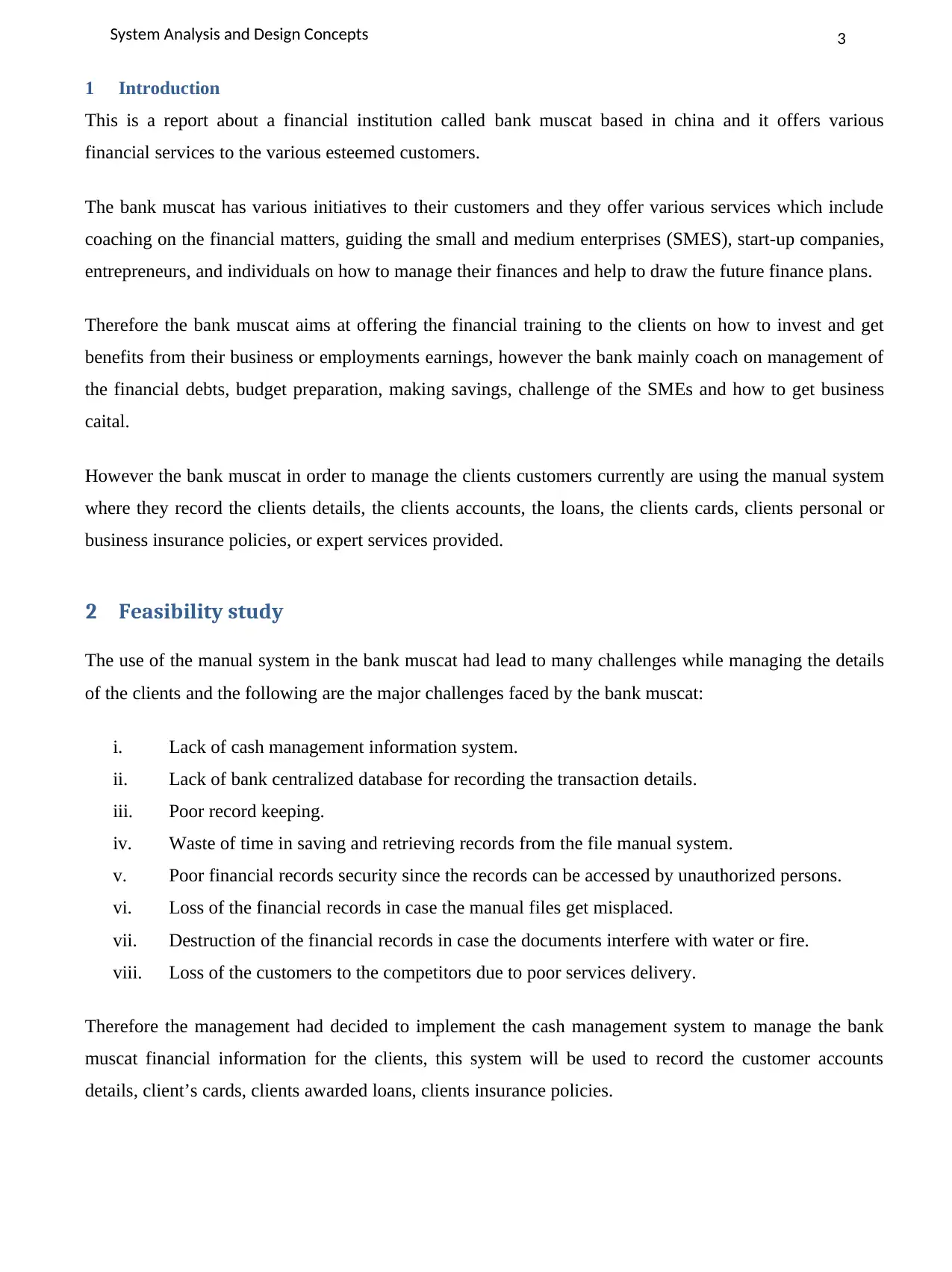
3System Analysis and Design Concepts
1 Introduction
This is a report about a financial institution called bank muscat based in china and it offers various
financial services to the various esteemed customers.
The bank muscat has various initiatives to their customers and they offer various services which include
coaching on the financial matters, guiding the small and medium enterprises (SMES), start-up companies,
entrepreneurs, and individuals on how to manage their finances and help to draw the future finance plans.
Therefore the bank muscat aims at offering the financial training to the clients on how to invest and get
benefits from their business or employments earnings, however the bank mainly coach on management of
the financial debts, budget preparation, making savings, challenge of the SMEs and how to get business
caital.
However the bank muscat in order to manage the clients customers currently are using the manual system
where they record the clients details, the clients accounts, the loans, the clients cards, clients personal or
business insurance policies, or expert services provided.
2 Feasibility study
The use of the manual system in the bank muscat had lead to many challenges while managing the details
of the clients and the following are the major challenges faced by the bank muscat:
i. Lack of cash management information system.
ii. Lack of bank centralized database for recording the transaction details.
iii. Poor record keeping.
iv. Waste of time in saving and retrieving records from the file manual system.
v. Poor financial records security since the records can be accessed by unauthorized persons.
vi. Loss of the financial records in case the manual files get misplaced.
vii. Destruction of the financial records in case the documents interfere with water or fire.
viii. Loss of the customers to the competitors due to poor services delivery.
Therefore the management had decided to implement the cash management system to manage the bank
muscat financial information for the clients, this system will be used to record the customer accounts
details, client’s cards, clients awarded loans, clients insurance policies.
1 Introduction
This is a report about a financial institution called bank muscat based in china and it offers various
financial services to the various esteemed customers.
The bank muscat has various initiatives to their customers and they offer various services which include
coaching on the financial matters, guiding the small and medium enterprises (SMES), start-up companies,
entrepreneurs, and individuals on how to manage their finances and help to draw the future finance plans.
Therefore the bank muscat aims at offering the financial training to the clients on how to invest and get
benefits from their business or employments earnings, however the bank mainly coach on management of
the financial debts, budget preparation, making savings, challenge of the SMEs and how to get business
caital.
However the bank muscat in order to manage the clients customers currently are using the manual system
where they record the clients details, the clients accounts, the loans, the clients cards, clients personal or
business insurance policies, or expert services provided.
2 Feasibility study
The use of the manual system in the bank muscat had lead to many challenges while managing the details
of the clients and the following are the major challenges faced by the bank muscat:
i. Lack of cash management information system.
ii. Lack of bank centralized database for recording the transaction details.
iii. Poor record keeping.
iv. Waste of time in saving and retrieving records from the file manual system.
v. Poor financial records security since the records can be accessed by unauthorized persons.
vi. Loss of the financial records in case the manual files get misplaced.
vii. Destruction of the financial records in case the documents interfere with water or fire.
viii. Loss of the customers to the competitors due to poor services delivery.
Therefore the management had decided to implement the cash management system to manage the bank
muscat financial information for the clients, this system will be used to record the customer accounts
details, client’s cards, clients awarded loans, clients insurance policies.
⊘ This is a preview!⊘
Do you want full access?
Subscribe today to unlock all pages.

Trusted by 1+ million students worldwide
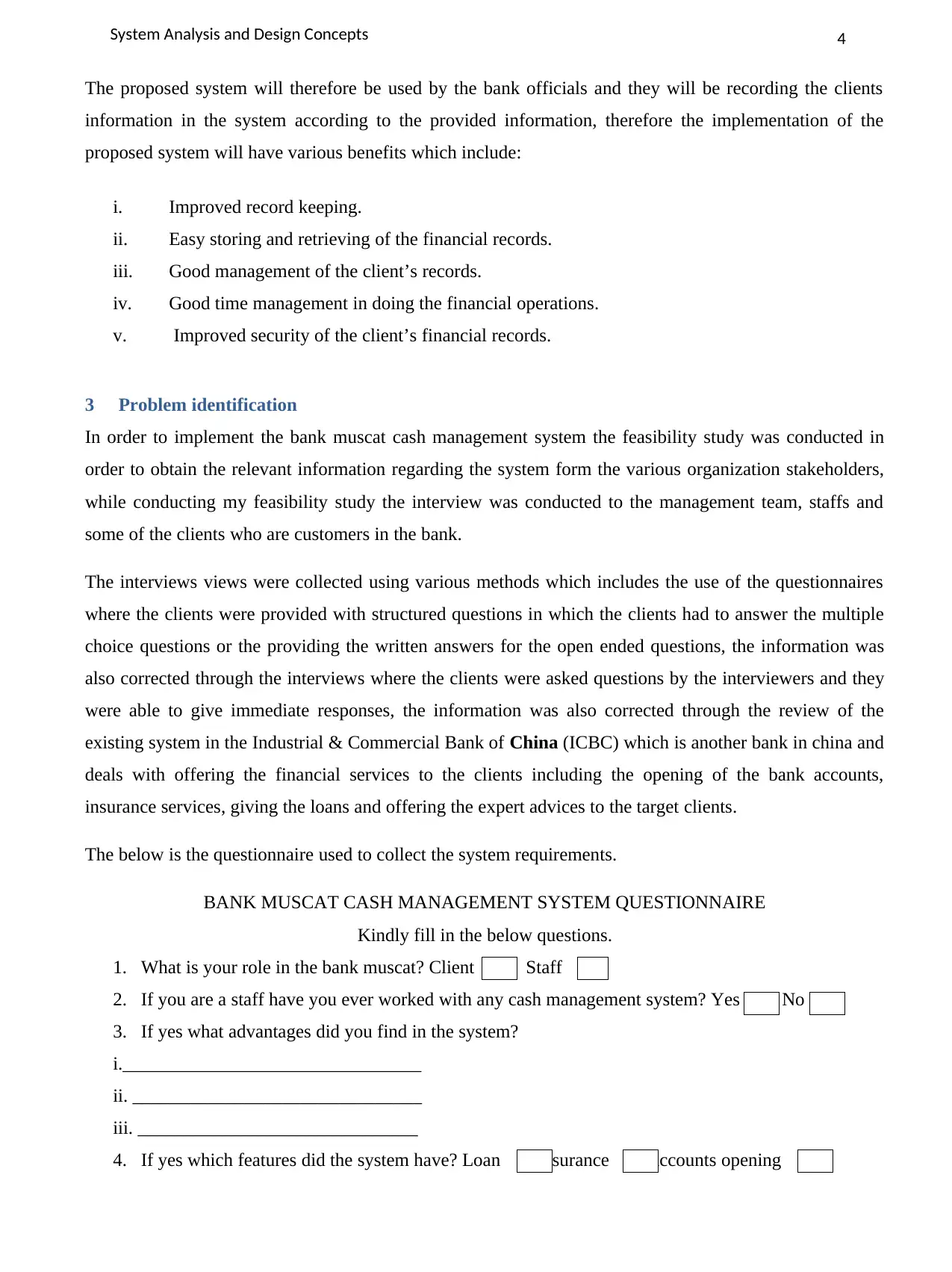
4System Analysis and Design Concepts
The proposed system will therefore be used by the bank officials and they will be recording the clients
information in the system according to the provided information, therefore the implementation of the
proposed system will have various benefits which include:
i. Improved record keeping.
ii. Easy storing and retrieving of the financial records.
iii. Good management of the client’s records.
iv. Good time management in doing the financial operations.
v. Improved security of the client’s financial records.
3 Problem identification
In order to implement the bank muscat cash management system the feasibility study was conducted in
order to obtain the relevant information regarding the system form the various organization stakeholders,
while conducting my feasibility study the interview was conducted to the management team, staffs and
some of the clients who are customers in the bank.
The interviews views were collected using various methods which includes the use of the questionnaires
where the clients were provided with structured questions in which the clients had to answer the multiple
choice questions or the providing the written answers for the open ended questions, the information was
also corrected through the interviews where the clients were asked questions by the interviewers and they
were able to give immediate responses, the information was also corrected through the review of the
existing system in the Industrial & Commercial Bank of China (ICBC) which is another bank in china and
deals with offering the financial services to the clients including the opening of the bank accounts,
insurance services, giving the loans and offering the expert advices to the target clients.
The below is the questionnaire used to collect the system requirements.
BANK MUSCAT CASH MANAGEMENT SYSTEM QUESTIONNAIRE
Kindly fill in the below questions.
1. What is your role in the bank muscat? Client Staff
2. If you are a staff have you ever worked with any cash management system? Yes No
3. If yes what advantages did you find in the system?
i.________________________________
ii. _______________________________
iii. ______________________________
4. If yes which features did the system have? Loan insurance accounts opening
The proposed system will therefore be used by the bank officials and they will be recording the clients
information in the system according to the provided information, therefore the implementation of the
proposed system will have various benefits which include:
i. Improved record keeping.
ii. Easy storing and retrieving of the financial records.
iii. Good management of the client’s records.
iv. Good time management in doing the financial operations.
v. Improved security of the client’s financial records.
3 Problem identification
In order to implement the bank muscat cash management system the feasibility study was conducted in
order to obtain the relevant information regarding the system form the various organization stakeholders,
while conducting my feasibility study the interview was conducted to the management team, staffs and
some of the clients who are customers in the bank.
The interviews views were collected using various methods which includes the use of the questionnaires
where the clients were provided with structured questions in which the clients had to answer the multiple
choice questions or the providing the written answers for the open ended questions, the information was
also corrected through the interviews where the clients were asked questions by the interviewers and they
were able to give immediate responses, the information was also corrected through the review of the
existing system in the Industrial & Commercial Bank of China (ICBC) which is another bank in china and
deals with offering the financial services to the clients including the opening of the bank accounts,
insurance services, giving the loans and offering the expert advices to the target clients.
The below is the questionnaire used to collect the system requirements.
BANK MUSCAT CASH MANAGEMENT SYSTEM QUESTIONNAIRE
Kindly fill in the below questions.
1. What is your role in the bank muscat? Client Staff
2. If you are a staff have you ever worked with any cash management system? Yes No
3. If yes what advantages did you find in the system?
i.________________________________
ii. _______________________________
iii. ______________________________
4. If yes which features did the system have? Loan insurance accounts opening
Paraphrase This Document
Need a fresh take? Get an instant paraphrase of this document with our AI Paraphraser
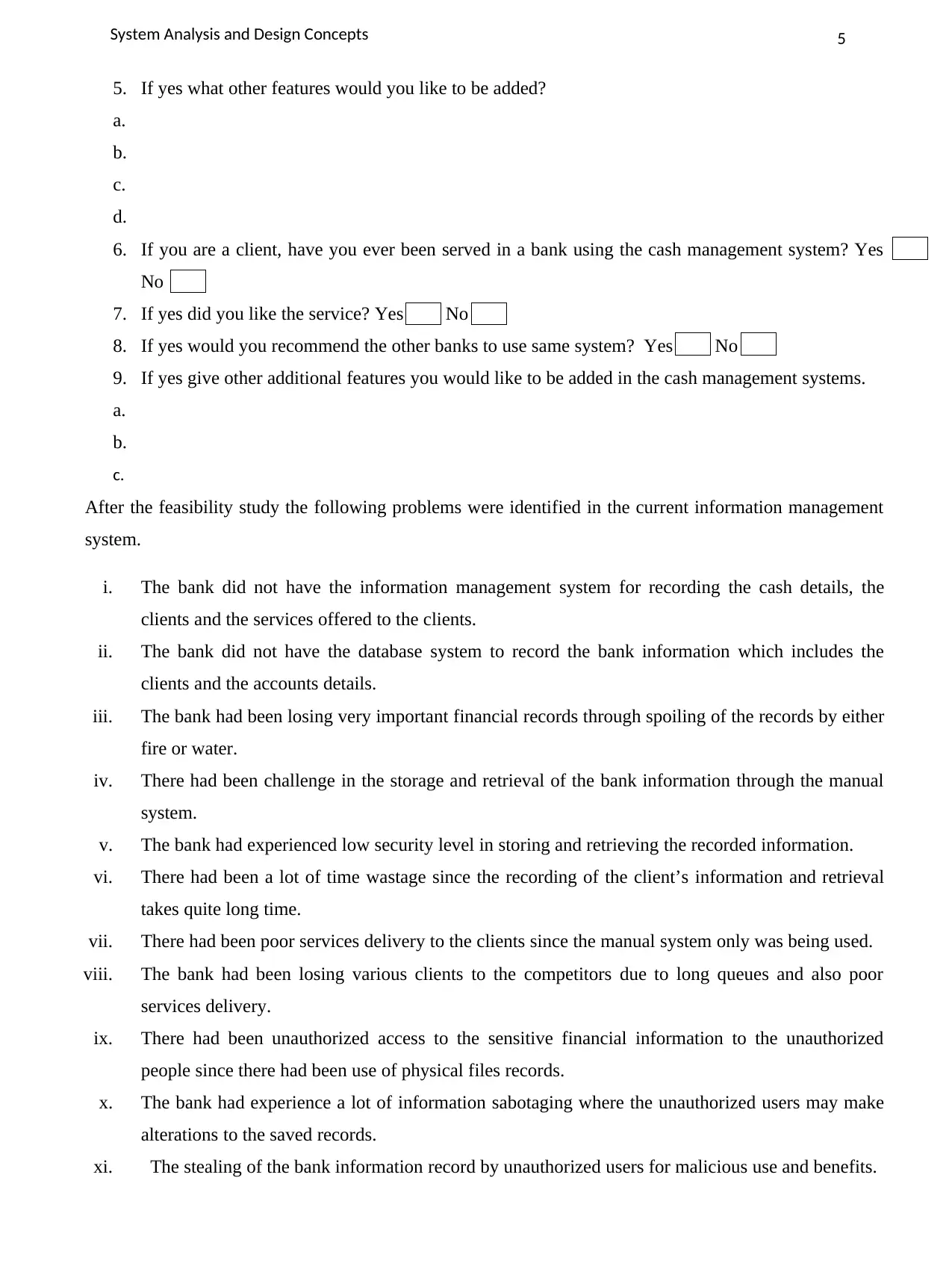
5System Analysis and Design Concepts
5. If yes what other features would you like to be added?
a.
b.
c.
d.
6. If you are a client, have you ever been served in a bank using the cash management system? Yes
No
7. If yes did you like the service? Yes No
8. If yes would you recommend the other banks to use same system? Yes No
9. If yes give other additional features you would like to be added in the cash management systems.
a.
b.
c.
After the feasibility study the following problems were identified in the current information management
system.
i. The bank did not have the information management system for recording the cash details, the
clients and the services offered to the clients.
ii. The bank did not have the database system to record the bank information which includes the
clients and the accounts details.
iii. The bank had been losing very important financial records through spoiling of the records by either
fire or water.
iv. There had been challenge in the storage and retrieval of the bank information through the manual
system.
v. The bank had experienced low security level in storing and retrieving the recorded information.
vi. There had been a lot of time wastage since the recording of the client’s information and retrieval
takes quite long time.
vii. There had been poor services delivery to the clients since the manual system only was being used.
viii. The bank had been losing various clients to the competitors due to long queues and also poor
services delivery.
ix. There had been unauthorized access to the sensitive financial information to the unauthorized
people since there had been use of physical files records.
x. The bank had experience a lot of information sabotaging where the unauthorized users may make
alterations to the saved records.
xi. The stealing of the bank information record by unauthorized users for malicious use and benefits.
5. If yes what other features would you like to be added?
a.
b.
c.
d.
6. If you are a client, have you ever been served in a bank using the cash management system? Yes
No
7. If yes did you like the service? Yes No
8. If yes would you recommend the other banks to use same system? Yes No
9. If yes give other additional features you would like to be added in the cash management systems.
a.
b.
c.
After the feasibility study the following problems were identified in the current information management
system.
i. The bank did not have the information management system for recording the cash details, the
clients and the services offered to the clients.
ii. The bank did not have the database system to record the bank information which includes the
clients and the accounts details.
iii. The bank had been losing very important financial records through spoiling of the records by either
fire or water.
iv. There had been challenge in the storage and retrieval of the bank information through the manual
system.
v. The bank had experienced low security level in storing and retrieving the recorded information.
vi. There had been a lot of time wastage since the recording of the client’s information and retrieval
takes quite long time.
vii. There had been poor services delivery to the clients since the manual system only was being used.
viii. The bank had been losing various clients to the competitors due to long queues and also poor
services delivery.
ix. There had been unauthorized access to the sensitive financial information to the unauthorized
people since there had been use of physical files records.
x. The bank had experience a lot of information sabotaging where the unauthorized users may make
alterations to the saved records.
xi. The stealing of the bank information record by unauthorized users for malicious use and benefits.
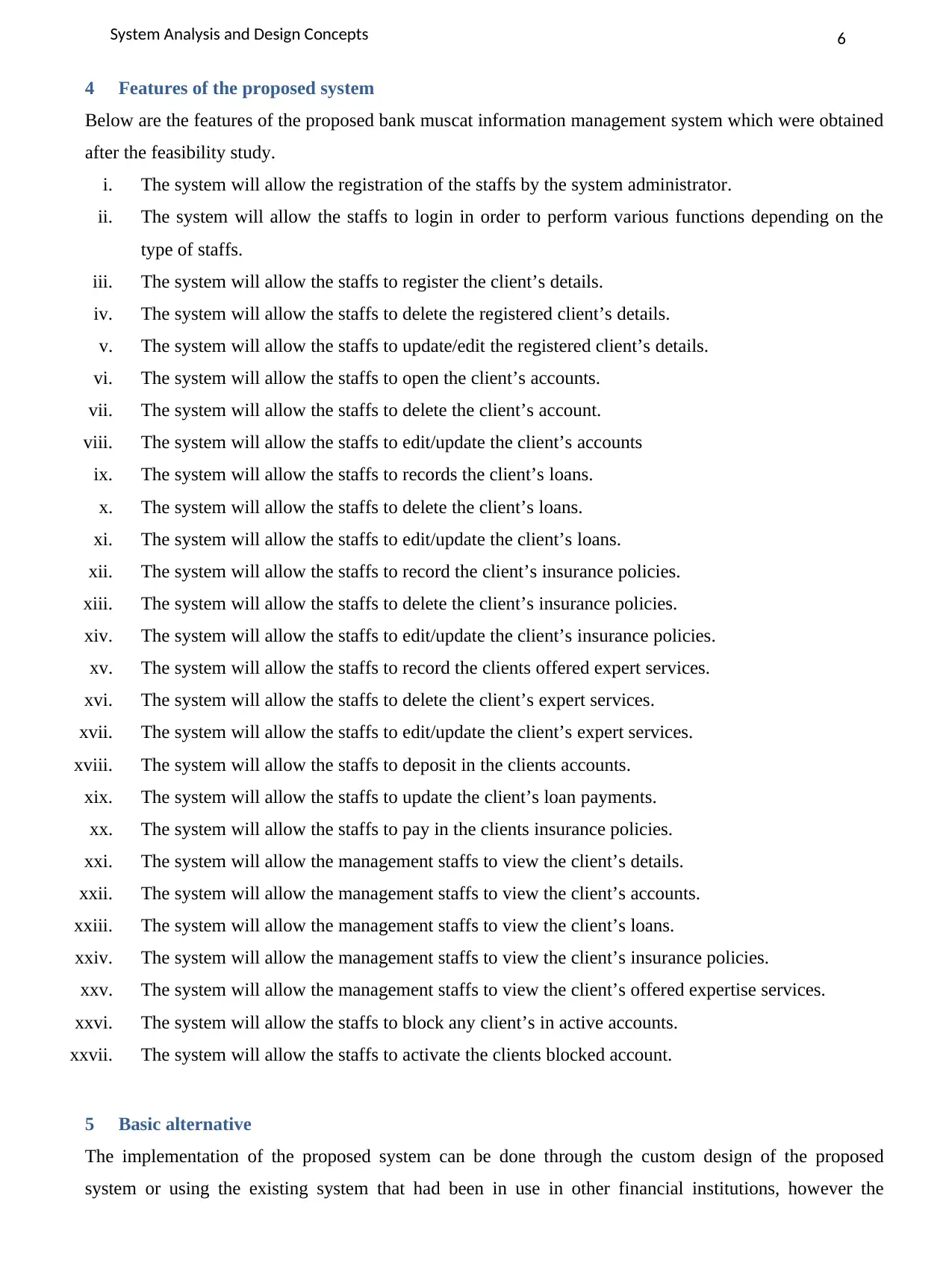
6System Analysis and Design Concepts
4 Features of the proposed system
Below are the features of the proposed bank muscat information management system which were obtained
after the feasibility study.
i. The system will allow the registration of the staffs by the system administrator.
ii. The system will allow the staffs to login in order to perform various functions depending on the
type of staffs.
iii. The system will allow the staffs to register the client’s details.
iv. The system will allow the staffs to delete the registered client’s details.
v. The system will allow the staffs to update/edit the registered client’s details.
vi. The system will allow the staffs to open the client’s accounts.
vii. The system will allow the staffs to delete the client’s account.
viii. The system will allow the staffs to edit/update the client’s accounts
ix. The system will allow the staffs to records the client’s loans.
x. The system will allow the staffs to delete the client’s loans.
xi. The system will allow the staffs to edit/update the client’s loans.
xii. The system will allow the staffs to record the client’s insurance policies.
xiii. The system will allow the staffs to delete the client’s insurance policies.
xiv. The system will allow the staffs to edit/update the client’s insurance policies.
xv. The system will allow the staffs to record the clients offered expert services.
xvi. The system will allow the staffs to delete the client’s expert services.
xvii. The system will allow the staffs to edit/update the client’s expert services.
xviii. The system will allow the staffs to deposit in the clients accounts.
xix. The system will allow the staffs to update the client’s loan payments.
xx. The system will allow the staffs to pay in the clients insurance policies.
xxi. The system will allow the management staffs to view the client’s details.
xxii. The system will allow the management staffs to view the client’s accounts.
xxiii. The system will allow the management staffs to view the client’s loans.
xxiv. The system will allow the management staffs to view the client’s insurance policies.
xxv. The system will allow the management staffs to view the client’s offered expertise services.
xxvi. The system will allow the staffs to block any client’s in active accounts.
xxvii. The system will allow the staffs to activate the clients blocked account.
5 Basic alternative
The implementation of the proposed system can be done through the custom design of the proposed
system or using the existing system that had been in use in other financial institutions, however the
4 Features of the proposed system
Below are the features of the proposed bank muscat information management system which were obtained
after the feasibility study.
i. The system will allow the registration of the staffs by the system administrator.
ii. The system will allow the staffs to login in order to perform various functions depending on the
type of staffs.
iii. The system will allow the staffs to register the client’s details.
iv. The system will allow the staffs to delete the registered client’s details.
v. The system will allow the staffs to update/edit the registered client’s details.
vi. The system will allow the staffs to open the client’s accounts.
vii. The system will allow the staffs to delete the client’s account.
viii. The system will allow the staffs to edit/update the client’s accounts
ix. The system will allow the staffs to records the client’s loans.
x. The system will allow the staffs to delete the client’s loans.
xi. The system will allow the staffs to edit/update the client’s loans.
xii. The system will allow the staffs to record the client’s insurance policies.
xiii. The system will allow the staffs to delete the client’s insurance policies.
xiv. The system will allow the staffs to edit/update the client’s insurance policies.
xv. The system will allow the staffs to record the clients offered expert services.
xvi. The system will allow the staffs to delete the client’s expert services.
xvii. The system will allow the staffs to edit/update the client’s expert services.
xviii. The system will allow the staffs to deposit in the clients accounts.
xix. The system will allow the staffs to update the client’s loan payments.
xx. The system will allow the staffs to pay in the clients insurance policies.
xxi. The system will allow the management staffs to view the client’s details.
xxii. The system will allow the management staffs to view the client’s accounts.
xxiii. The system will allow the management staffs to view the client’s loans.
xxiv. The system will allow the management staffs to view the client’s insurance policies.
xxv. The system will allow the management staffs to view the client’s offered expertise services.
xxvi. The system will allow the staffs to block any client’s in active accounts.
xxvii. The system will allow the staffs to activate the clients blocked account.
5 Basic alternative
The implementation of the proposed system can be done through the custom design of the proposed
system or using the existing system that had been in use in other financial institutions, however the
⊘ This is a preview!⊘
Do you want full access?
Subscribe today to unlock all pages.

Trusted by 1+ million students worldwide
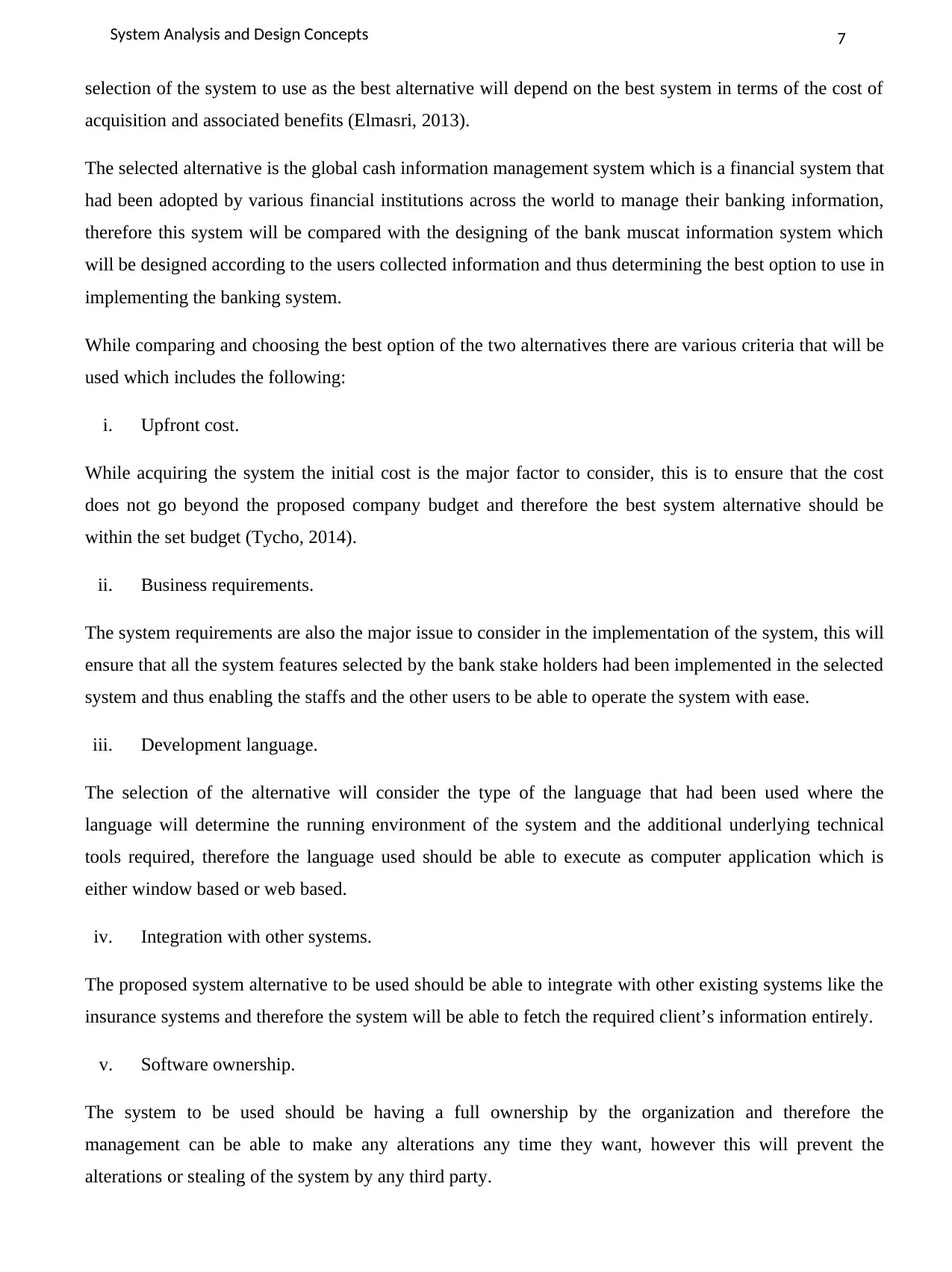
7System Analysis and Design Concepts
selection of the system to use as the best alternative will depend on the best system in terms of the cost of
acquisition and associated benefits (Elmasri, 2013).
The selected alternative is the global cash information management system which is a financial system that
had been adopted by various financial institutions across the world to manage their banking information,
therefore this system will be compared with the designing of the bank muscat information system which
will be designed according to the users collected information and thus determining the best option to use in
implementing the banking system.
While comparing and choosing the best option of the two alternatives there are various criteria that will be
used which includes the following:
i. Upfront cost.
While acquiring the system the initial cost is the major factor to consider, this is to ensure that the cost
does not go beyond the proposed company budget and therefore the best system alternative should be
within the set budget (Tycho, 2014).
ii. Business requirements.
The system requirements are also the major issue to consider in the implementation of the system, this will
ensure that all the system features selected by the bank stake holders had been implemented in the selected
system and thus enabling the staffs and the other users to be able to operate the system with ease.
iii. Development language.
The selection of the alternative will consider the type of the language that had been used where the
language will determine the running environment of the system and the additional underlying technical
tools required, therefore the language used should be able to execute as computer application which is
either window based or web based.
iv. Integration with other systems.
The proposed system alternative to be used should be able to integrate with other existing systems like the
insurance systems and therefore the system will be able to fetch the required client’s information entirely.
v. Software ownership.
The system to be used should be having a full ownership by the organization and therefore the
management can be able to make any alterations any time they want, however this will prevent the
alterations or stealing of the system by any third party.
selection of the system to use as the best alternative will depend on the best system in terms of the cost of
acquisition and associated benefits (Elmasri, 2013).
The selected alternative is the global cash information management system which is a financial system that
had been adopted by various financial institutions across the world to manage their banking information,
therefore this system will be compared with the designing of the bank muscat information system which
will be designed according to the users collected information and thus determining the best option to use in
implementing the banking system.
While comparing and choosing the best option of the two alternatives there are various criteria that will be
used which includes the following:
i. Upfront cost.
While acquiring the system the initial cost is the major factor to consider, this is to ensure that the cost
does not go beyond the proposed company budget and therefore the best system alternative should be
within the set budget (Tycho, 2014).
ii. Business requirements.
The system requirements are also the major issue to consider in the implementation of the system, this will
ensure that all the system features selected by the bank stake holders had been implemented in the selected
system and thus enabling the staffs and the other users to be able to operate the system with ease.
iii. Development language.
The selection of the alternative will consider the type of the language that had been used where the
language will determine the running environment of the system and the additional underlying technical
tools required, therefore the language used should be able to execute as computer application which is
either window based or web based.
iv. Integration with other systems.
The proposed system alternative to be used should be able to integrate with other existing systems like the
insurance systems and therefore the system will be able to fetch the required client’s information entirely.
v. Software ownership.
The system to be used should be having a full ownership by the organization and therefore the
management can be able to make any alterations any time they want, however this will prevent the
alterations or stealing of the system by any third party.
Paraphrase This Document
Need a fresh take? Get an instant paraphrase of this document with our AI Paraphraser
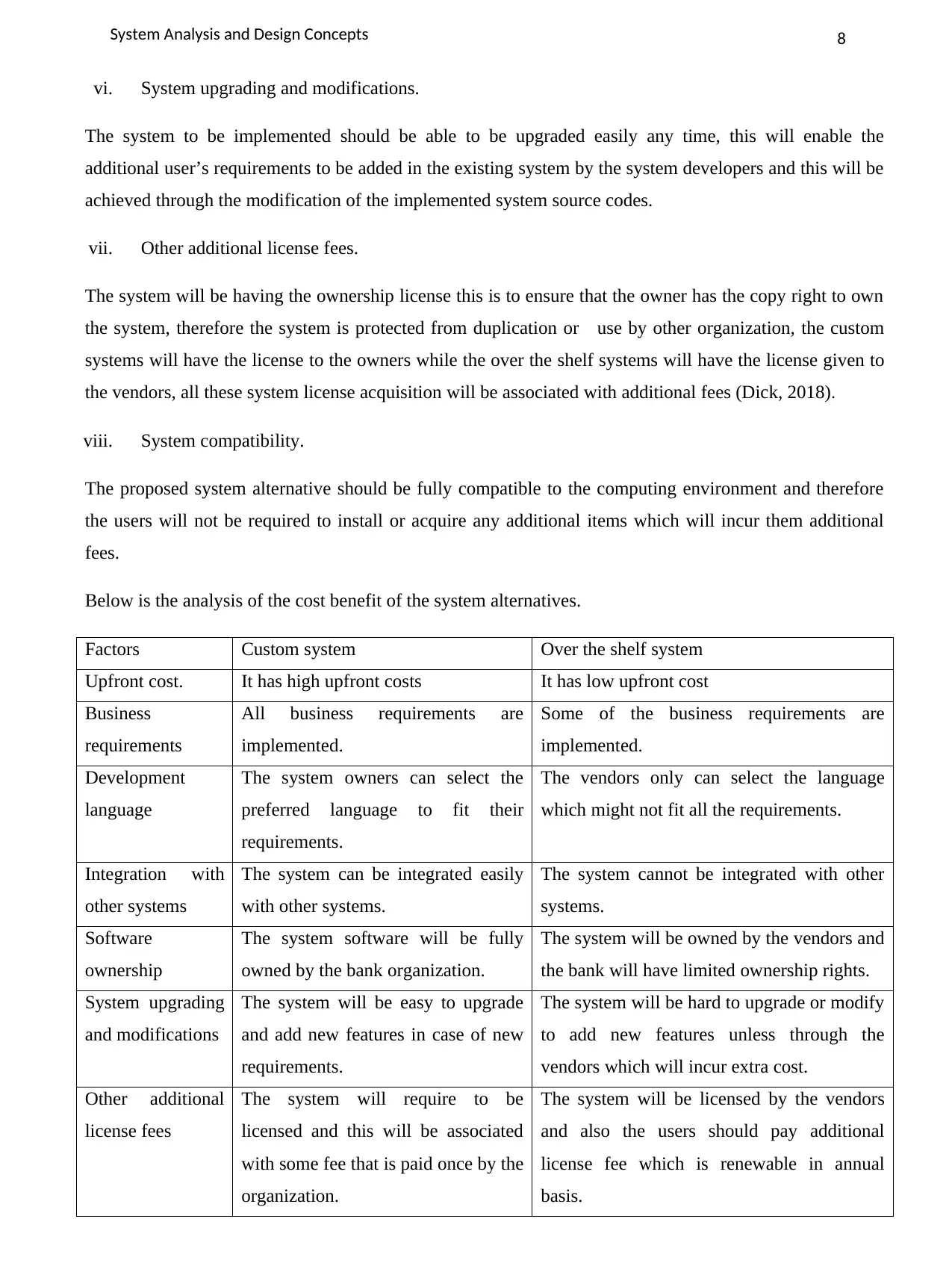
8System Analysis and Design Concepts
vi. System upgrading and modifications.
The system to be implemented should be able to be upgraded easily any time, this will enable the
additional user’s requirements to be added in the existing system by the system developers and this will be
achieved through the modification of the implemented system source codes.
vii. Other additional license fees.
The system will be having the ownership license this is to ensure that the owner has the copy right to own
the system, therefore the system is protected from duplication or use by other organization, the custom
systems will have the license to the owners while the over the shelf systems will have the license given to
the vendors, all these system license acquisition will be associated with additional fees (Dick, 2018).
viii. System compatibility.
The proposed system alternative should be fully compatible to the computing environment and therefore
the users will not be required to install or acquire any additional items which will incur them additional
fees.
Below is the analysis of the cost benefit of the system alternatives.
Factors Custom system Over the shelf system
Upfront cost. It has high upfront costs It has low upfront cost
Business
requirements
All business requirements are
implemented.
Some of the business requirements are
implemented.
Development
language
The system owners can select the
preferred language to fit their
requirements.
The vendors only can select the language
which might not fit all the requirements.
Integration with
other systems
The system can be integrated easily
with other systems.
The system cannot be integrated with other
systems.
Software
ownership
The system software will be fully
owned by the bank organization.
The system will be owned by the vendors and
the bank will have limited ownership rights.
System upgrading
and modifications
The system will be easy to upgrade
and add new features in case of new
requirements.
The system will be hard to upgrade or modify
to add new features unless through the
vendors which will incur extra cost.
Other additional
license fees
The system will require to be
licensed and this will be associated
with some fee that is paid once by the
organization.
The system will be licensed by the vendors
and also the users should pay additional
license fee which is renewable in annual
basis.
vi. System upgrading and modifications.
The system to be implemented should be able to be upgraded easily any time, this will enable the
additional user’s requirements to be added in the existing system by the system developers and this will be
achieved through the modification of the implemented system source codes.
vii. Other additional license fees.
The system will be having the ownership license this is to ensure that the owner has the copy right to own
the system, therefore the system is protected from duplication or use by other organization, the custom
systems will have the license to the owners while the over the shelf systems will have the license given to
the vendors, all these system license acquisition will be associated with additional fees (Dick, 2018).
viii. System compatibility.
The proposed system alternative should be fully compatible to the computing environment and therefore
the users will not be required to install or acquire any additional items which will incur them additional
fees.
Below is the analysis of the cost benefit of the system alternatives.
Factors Custom system Over the shelf system
Upfront cost. It has high upfront costs It has low upfront cost
Business
requirements
All business requirements are
implemented.
Some of the business requirements are
implemented.
Development
language
The system owners can select the
preferred language to fit their
requirements.
The vendors only can select the language
which might not fit all the requirements.
Integration with
other systems
The system can be integrated easily
with other systems.
The system cannot be integrated with other
systems.
Software
ownership
The system software will be fully
owned by the bank organization.
The system will be owned by the vendors and
the bank will have limited ownership rights.
System upgrading
and modifications
The system will be easy to upgrade
and add new features in case of new
requirements.
The system will be hard to upgrade or modify
to add new features unless through the
vendors which will incur extra cost.
Other additional
license fees
The system will require to be
licensed and this will be associated
with some fee that is paid once by the
organization.
The system will be licensed by the vendors
and also the users should pay additional
license fee which is renewable in annual
basis.
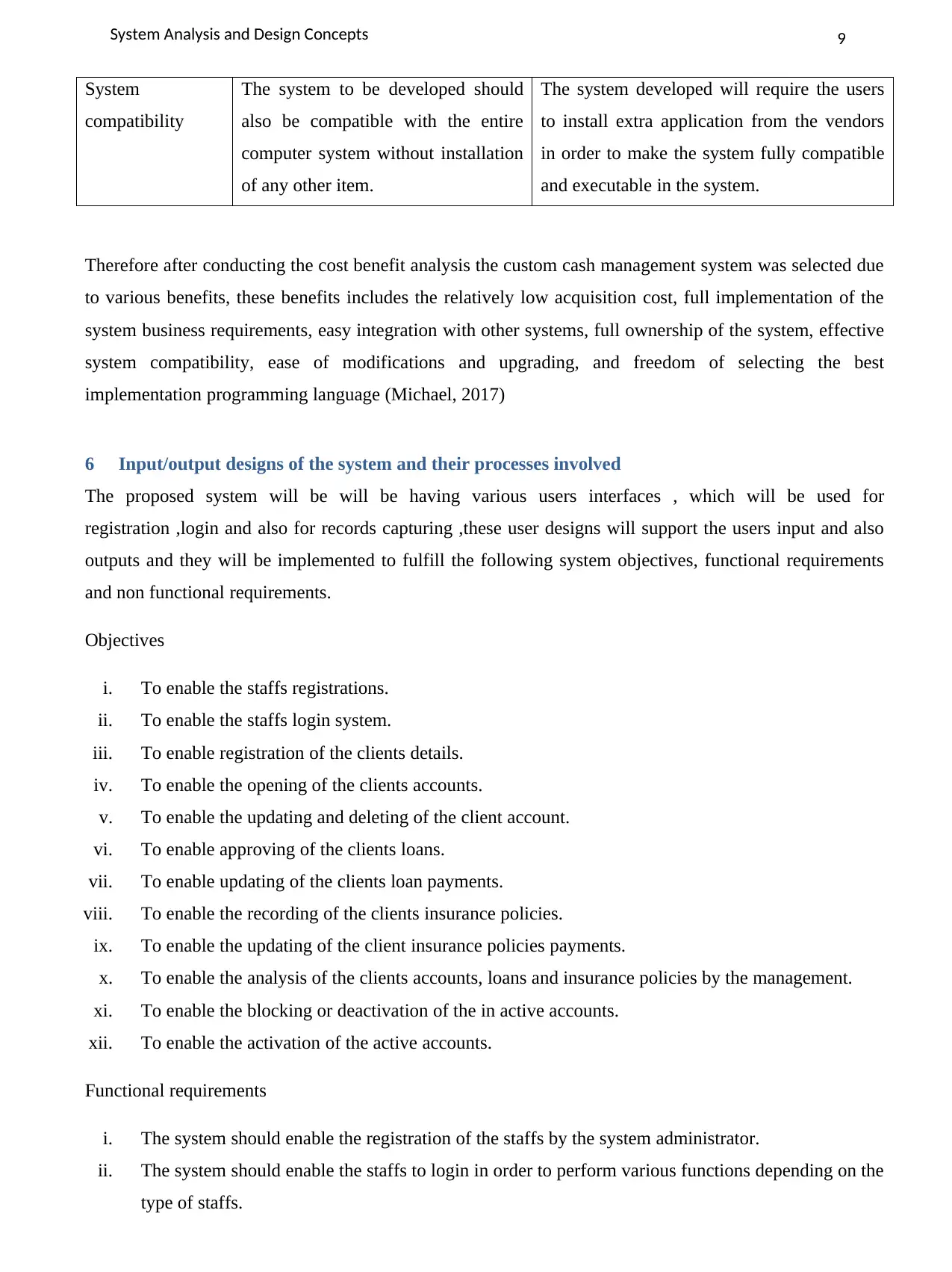
9System Analysis and Design Concepts
System
compatibility
The system to be developed should
also be compatible with the entire
computer system without installation
of any other item.
The system developed will require the users
to install extra application from the vendors
in order to make the system fully compatible
and executable in the system.
Therefore after conducting the cost benefit analysis the custom cash management system was selected due
to various benefits, these benefits includes the relatively low acquisition cost, full implementation of the
system business requirements, easy integration with other systems, full ownership of the system, effective
system compatibility, ease of modifications and upgrading, and freedom of selecting the best
implementation programming language (Michael, 2017)
6 Input/output designs of the system and their processes involved
The proposed system will be will be having various users interfaces , which will be used for
registration ,login and also for records capturing ,these user designs will support the users input and also
outputs and they will be implemented to fulfill the following system objectives, functional requirements
and non functional requirements.
Objectives
i. To enable the staffs registrations.
ii. To enable the staffs login system.
iii. To enable registration of the clients details.
iv. To enable the opening of the clients accounts.
v. To enable the updating and deleting of the client account.
vi. To enable approving of the clients loans.
vii. To enable updating of the clients loan payments.
viii. To enable the recording of the clients insurance policies.
ix. To enable the updating of the client insurance policies payments.
x. To enable the analysis of the clients accounts, loans and insurance policies by the management.
xi. To enable the blocking or deactivation of the in active accounts.
xii. To enable the activation of the active accounts.
Functional requirements
i. The system should enable the registration of the staffs by the system administrator.
ii. The system should enable the staffs to login in order to perform various functions depending on the
type of staffs.
System
compatibility
The system to be developed should
also be compatible with the entire
computer system without installation
of any other item.
The system developed will require the users
to install extra application from the vendors
in order to make the system fully compatible
and executable in the system.
Therefore after conducting the cost benefit analysis the custom cash management system was selected due
to various benefits, these benefits includes the relatively low acquisition cost, full implementation of the
system business requirements, easy integration with other systems, full ownership of the system, effective
system compatibility, ease of modifications and upgrading, and freedom of selecting the best
implementation programming language (Michael, 2017)
6 Input/output designs of the system and their processes involved
The proposed system will be will be having various users interfaces , which will be used for
registration ,login and also for records capturing ,these user designs will support the users input and also
outputs and they will be implemented to fulfill the following system objectives, functional requirements
and non functional requirements.
Objectives
i. To enable the staffs registrations.
ii. To enable the staffs login system.
iii. To enable registration of the clients details.
iv. To enable the opening of the clients accounts.
v. To enable the updating and deleting of the client account.
vi. To enable approving of the clients loans.
vii. To enable updating of the clients loan payments.
viii. To enable the recording of the clients insurance policies.
ix. To enable the updating of the client insurance policies payments.
x. To enable the analysis of the clients accounts, loans and insurance policies by the management.
xi. To enable the blocking or deactivation of the in active accounts.
xii. To enable the activation of the active accounts.
Functional requirements
i. The system should enable the registration of the staffs by the system administrator.
ii. The system should enable the staffs to login in order to perform various functions depending on the
type of staffs.
⊘ This is a preview!⊘
Do you want full access?
Subscribe today to unlock all pages.

Trusted by 1+ million students worldwide
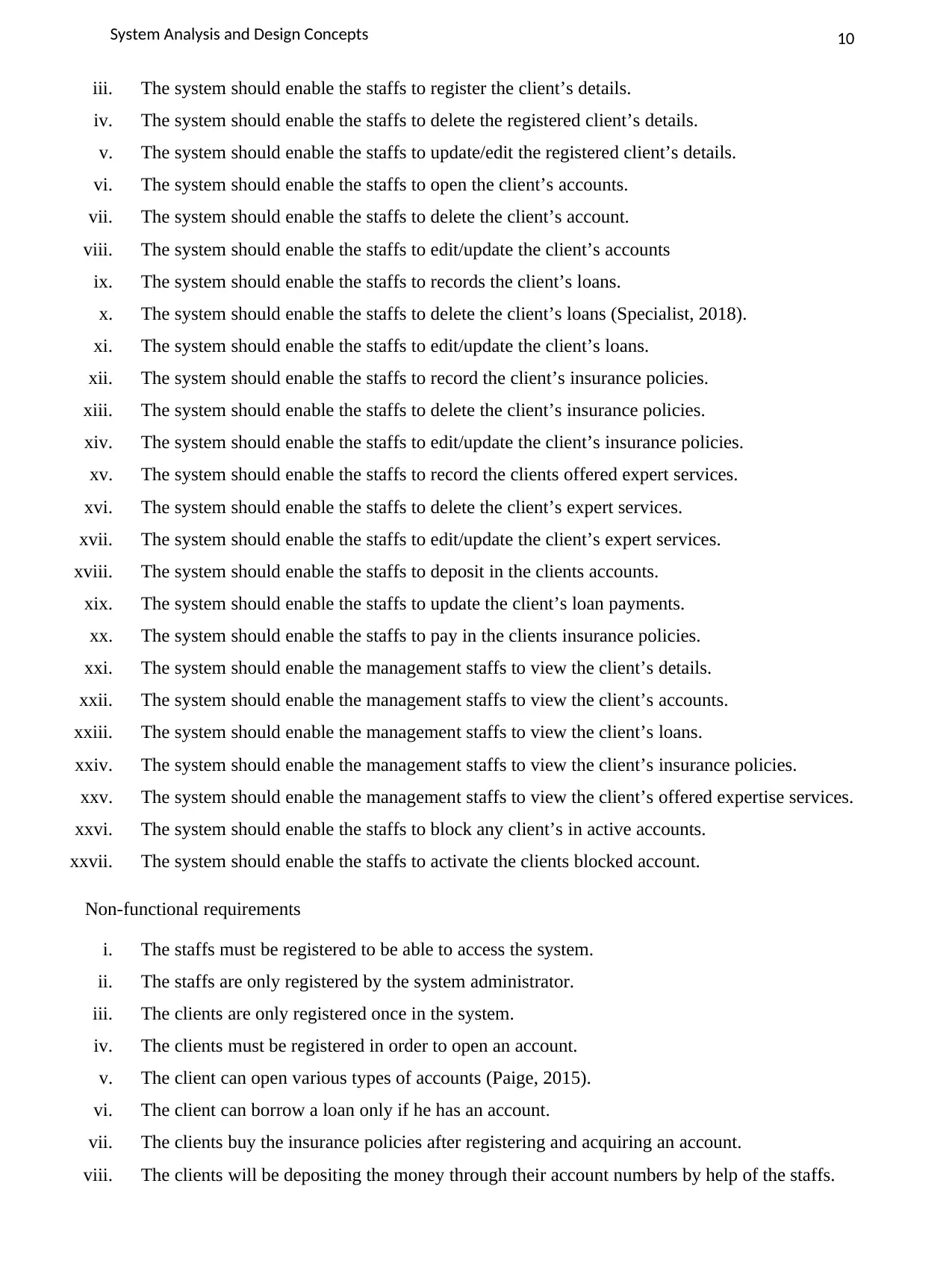
10System Analysis and Design Concepts
iii. The system should enable the staffs to register the client’s details.
iv. The system should enable the staffs to delete the registered client’s details.
v. The system should enable the staffs to update/edit the registered client’s details.
vi. The system should enable the staffs to open the client’s accounts.
vii. The system should enable the staffs to delete the client’s account.
viii. The system should enable the staffs to edit/update the client’s accounts
ix. The system should enable the staffs to records the client’s loans.
x. The system should enable the staffs to delete the client’s loans (Specialist, 2018).
xi. The system should enable the staffs to edit/update the client’s loans.
xii. The system should enable the staffs to record the client’s insurance policies.
xiii. The system should enable the staffs to delete the client’s insurance policies.
xiv. The system should enable the staffs to edit/update the client’s insurance policies.
xv. The system should enable the staffs to record the clients offered expert services.
xvi. The system should enable the staffs to delete the client’s expert services.
xvii. The system should enable the staffs to edit/update the client’s expert services.
xviii. The system should enable the staffs to deposit in the clients accounts.
xix. The system should enable the staffs to update the client’s loan payments.
xx. The system should enable the staffs to pay in the clients insurance policies.
xxi. The system should enable the management staffs to view the client’s details.
xxii. The system should enable the management staffs to view the client’s accounts.
xxiii. The system should enable the management staffs to view the client’s loans.
xxiv. The system should enable the management staffs to view the client’s insurance policies.
xxv. The system should enable the management staffs to view the client’s offered expertise services.
xxvi. The system should enable the staffs to block any client’s in active accounts.
xxvii. The system should enable the staffs to activate the clients blocked account.
Non-functional requirements
i. The staffs must be registered to be able to access the system.
ii. The staffs are only registered by the system administrator.
iii. The clients are only registered once in the system.
iv. The clients must be registered in order to open an account.
v. The client can open various types of accounts (Paige, 2015).
vi. The client can borrow a loan only if he has an account.
vii. The clients buy the insurance policies after registering and acquiring an account.
viii. The clients will be depositing the money through their account numbers by help of the staffs.
iii. The system should enable the staffs to register the client’s details.
iv. The system should enable the staffs to delete the registered client’s details.
v. The system should enable the staffs to update/edit the registered client’s details.
vi. The system should enable the staffs to open the client’s accounts.
vii. The system should enable the staffs to delete the client’s account.
viii. The system should enable the staffs to edit/update the client’s accounts
ix. The system should enable the staffs to records the client’s loans.
x. The system should enable the staffs to delete the client’s loans (Specialist, 2018).
xi. The system should enable the staffs to edit/update the client’s loans.
xii. The system should enable the staffs to record the client’s insurance policies.
xiii. The system should enable the staffs to delete the client’s insurance policies.
xiv. The system should enable the staffs to edit/update the client’s insurance policies.
xv. The system should enable the staffs to record the clients offered expert services.
xvi. The system should enable the staffs to delete the client’s expert services.
xvii. The system should enable the staffs to edit/update the client’s expert services.
xviii. The system should enable the staffs to deposit in the clients accounts.
xix. The system should enable the staffs to update the client’s loan payments.
xx. The system should enable the staffs to pay in the clients insurance policies.
xxi. The system should enable the management staffs to view the client’s details.
xxii. The system should enable the management staffs to view the client’s accounts.
xxiii. The system should enable the management staffs to view the client’s loans.
xxiv. The system should enable the management staffs to view the client’s insurance policies.
xxv. The system should enable the management staffs to view the client’s offered expertise services.
xxvi. The system should enable the staffs to block any client’s in active accounts.
xxvii. The system should enable the staffs to activate the clients blocked account.
Non-functional requirements
i. The staffs must be registered to be able to access the system.
ii. The staffs are only registered by the system administrator.
iii. The clients are only registered once in the system.
iv. The clients must be registered in order to open an account.
v. The client can open various types of accounts (Paige, 2015).
vi. The client can borrow a loan only if he has an account.
vii. The clients buy the insurance policies after registering and acquiring an account.
viii. The clients will be depositing the money through their account numbers by help of the staffs.
Paraphrase This Document
Need a fresh take? Get an instant paraphrase of this document with our AI Paraphraser
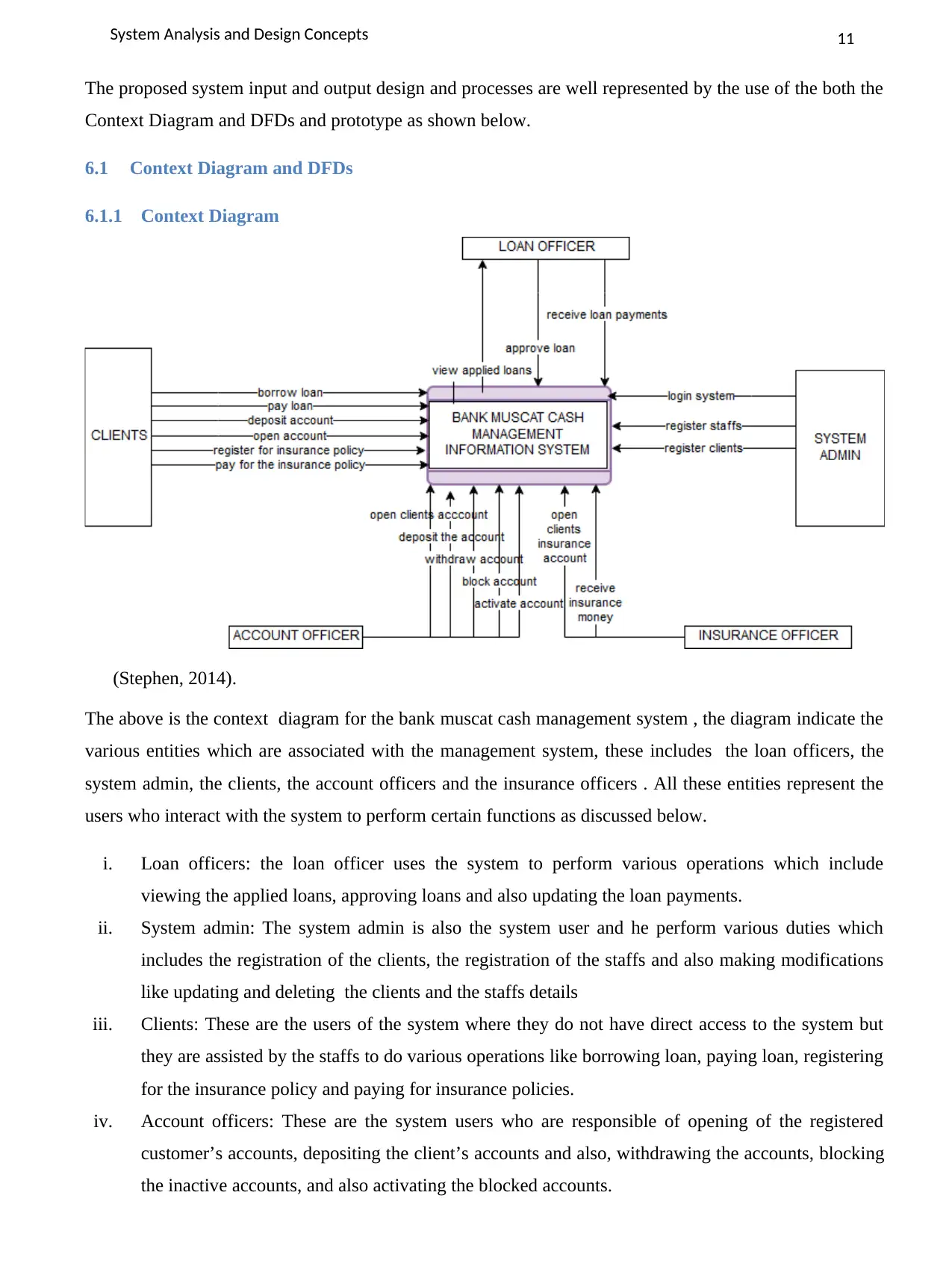
11System Analysis and Design Concepts
The proposed system input and output design and processes are well represented by the use of the both the
Context Diagram and DFDs and prototype as shown below.
6.1 Context Diagram and DFDs
6.1.1 Context Diagram
(Stephen, 2014).
The above is the context diagram for the bank muscat cash management system , the diagram indicate the
various entities which are associated with the management system, these includes the loan officers, the
system admin, the clients, the account officers and the insurance officers . All these entities represent the
users who interact with the system to perform certain functions as discussed below.
i. Loan officers: the loan officer uses the system to perform various operations which include
viewing the applied loans, approving loans and also updating the loan payments.
ii. System admin: The system admin is also the system user and he perform various duties which
includes the registration of the clients, the registration of the staffs and also making modifications
like updating and deleting the clients and the staffs details
iii. Clients: These are the users of the system where they do not have direct access to the system but
they are assisted by the staffs to do various operations like borrowing loan, paying loan, registering
for the insurance policy and paying for insurance policies.
iv. Account officers: These are the system users who are responsible of opening of the registered
customer’s accounts, depositing the client’s accounts and also, withdrawing the accounts, blocking
the inactive accounts, and also activating the blocked accounts.
The proposed system input and output design and processes are well represented by the use of the both the
Context Diagram and DFDs and prototype as shown below.
6.1 Context Diagram and DFDs
6.1.1 Context Diagram
(Stephen, 2014).
The above is the context diagram for the bank muscat cash management system , the diagram indicate the
various entities which are associated with the management system, these includes the loan officers, the
system admin, the clients, the account officers and the insurance officers . All these entities represent the
users who interact with the system to perform certain functions as discussed below.
i. Loan officers: the loan officer uses the system to perform various operations which include
viewing the applied loans, approving loans and also updating the loan payments.
ii. System admin: The system admin is also the system user and he perform various duties which
includes the registration of the clients, the registration of the staffs and also making modifications
like updating and deleting the clients and the staffs details
iii. Clients: These are the users of the system where they do not have direct access to the system but
they are assisted by the staffs to do various operations like borrowing loan, paying loan, registering
for the insurance policy and paying for insurance policies.
iv. Account officers: These are the system users who are responsible of opening of the registered
customer’s accounts, depositing the client’s accounts and also, withdrawing the accounts, blocking
the inactive accounts, and also activating the blocked accounts.
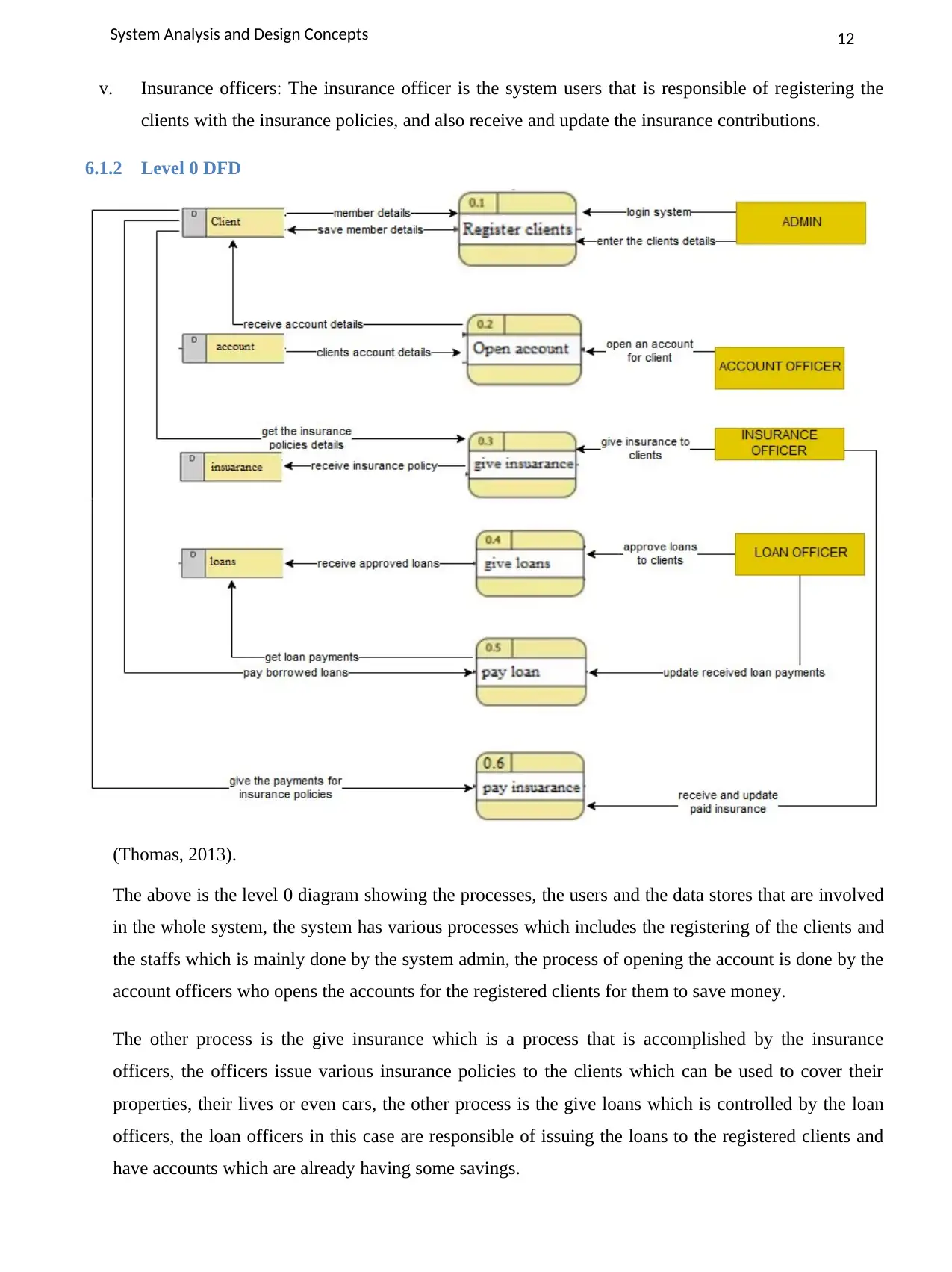
12System Analysis and Design Concepts
v. Insurance officers: The insurance officer is the system users that is responsible of registering the
clients with the insurance policies, and also receive and update the insurance contributions.
6.1.2 Level 0 DFD
(Thomas, 2013).
The above is the level 0 diagram showing the processes, the users and the data stores that are involved
in the whole system, the system has various processes which includes the registering of the clients and
the staffs which is mainly done by the system admin, the process of opening the account is done by the
account officers who opens the accounts for the registered clients for them to save money.
The other process is the give insurance which is a process that is accomplished by the insurance
officers, the officers issue various insurance policies to the clients which can be used to cover their
properties, their lives or even cars, the other process is the give loans which is controlled by the loan
officers, the loan officers in this case are responsible of issuing the loans to the registered clients and
have accounts which are already having some savings.
v. Insurance officers: The insurance officer is the system users that is responsible of registering the
clients with the insurance policies, and also receive and update the insurance contributions.
6.1.2 Level 0 DFD
(Thomas, 2013).
The above is the level 0 diagram showing the processes, the users and the data stores that are involved
in the whole system, the system has various processes which includes the registering of the clients and
the staffs which is mainly done by the system admin, the process of opening the account is done by the
account officers who opens the accounts for the registered clients for them to save money.
The other process is the give insurance which is a process that is accomplished by the insurance
officers, the officers issue various insurance policies to the clients which can be used to cover their
properties, their lives or even cars, the other process is the give loans which is controlled by the loan
officers, the loan officers in this case are responsible of issuing the loans to the registered clients and
have accounts which are already having some savings.
⊘ This is a preview!⊘
Do you want full access?
Subscribe today to unlock all pages.

Trusted by 1+ million students worldwide
1 out of 23
Related Documents
Your All-in-One AI-Powered Toolkit for Academic Success.
+13062052269
info@desklib.com
Available 24*7 on WhatsApp / Email
![[object Object]](/_next/static/media/star-bottom.7253800d.svg)
Unlock your academic potential
Copyright © 2020–2025 A2Z Services. All Rights Reserved. Developed and managed by ZUCOL.





